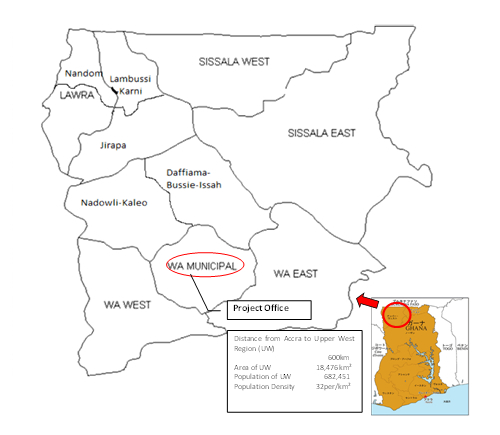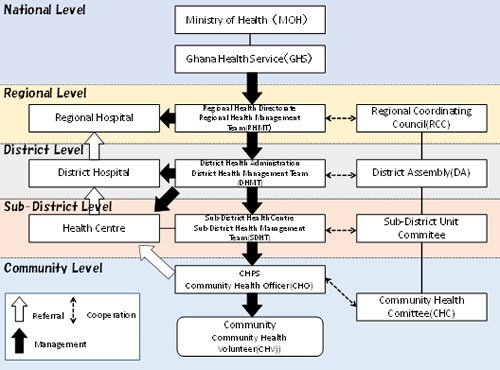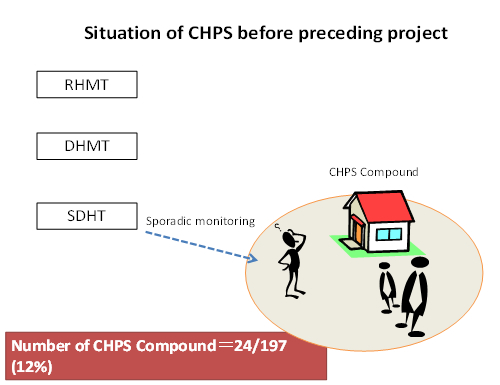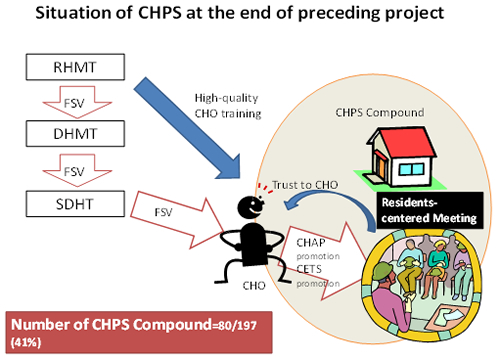Background of the Project implementation
1. Information on the Upper West Region
The Upper West Region is situated in the north-western part of the country and borders the Northern Region to the south, the Upper East Region to the northeast, the Republic of Cote d'Ivoire to the west, and Burkina Faso to the north. As shown in Figure 1, the region has the following 11 political districts: Wa Municipal; Wa West; Wa East; Jirapa; Lambussie-Karni; Lawra; Nandom; Nadowli-Kaleo; Daffiama-Bussie-Issah; Sissala East; and Sissala West.
 Map of Upper West Region
Map of Upper West Region
The climate is tropical with the lowest temperature of 22.6°C and the highest of 40.0°C. The rainy season is from May to October, with rainfall of 100–115 cm/annum and humidity ranging between 70 and 90% but falling to 20% in the dry season, from November to March. During the dry season, a cold, dry, and dusty wind called ‘harmattan' blows from the northeast across the region.
The population of the region in 2010 is 682,451. The region covers a total land area of 18,476 km2, with a population density of 32 people/km2. The Sissala East and Sissala West districts have the lowest population density at 11 people/km2, whilst the Lawra district has the highest at 94 people/km2. These low populated areas require people to move long distance to receive health services.
2. Information on Health Administration
In the Upper West Region, the Regional Health Administration of Ghana Health Service (GHS) is the highest authority on health issues. Under the Regional Health Administration, there are district health administration, sub-district health administration, and Community-based Health Planning and Services (CHPS). As public medical institutions, there are a regional hospital, district hospitals, and health centres. At the national policy, each sub-district health centre is designated as a Basic Emergency Obstetric and Neonatal Care (BEmONC) institution. At the CHPS compound, CHOs provide Antenatal Care (ANC) and Postnatal Care (PNC) through home visits; they also provide birth assistance in an emergency. Organization Chart of Upper West Health Governance
Organization Chart of Upper West Health Governance
3. CHPS Policy
The Project aims to improve maternal and neonatal health services in the Upper West Region through the CHPS policy, which is a unique feature of Ghanaian health policies. The CHPS policy started in 1999 as a result of a 1994 project in the Upper East Region. It is a community-based approach to provide basic health services nationwide in cooperation with the Ghanaian government, local communities, and their leaders. The Ghanaian government gives high priority to the promotion of the CHPS policy as an important activity to improve community health.
CHPS consists of a CHPS zone with 3,000 to 5,000 people in different communities. In each CHPS zone, a Community Health Management Committee (CHMC) is set up with a community leader, and a CHO lives and works in the CHPS zone. CHOs provide the following services in cooperation with the CHMC and Community Health Volunteers (CHVs).
- Understand and analyze health problems in communities.
- Help develop a community health plan for the people in the CHPS zone.
- Help prevent health problems by providing relevant information.
- Provide basic health services and initial diagnosis of disease.
- Conduct referrals to higher-tier medical institutions.
CHPS is the medical institution that community people access first, and it plays an important role in providing ANC and PNC as well as birth assistance in an emergency. The Project aims to expand CHPS and improve health services through CHPS policies.
4. Previous Project
Before the Project, JICA implemented a technical assistance project between March 2006 and February 2010 to increase CHPS in the region. Through capacity and systems development of GHS, the previous project conducted activities to expand the CHPS zone and improve the people's access to basic medical services.
The main objectives of the previous project were as follows: 1. strengthen the capacity of CHPS management at Regional Health Directorate, District Health Administration and Sub-District Health Centre; 2. strengthen CHOs' capacity to provide CHPS services; 3. develop and implement the Facilitative Supervision (FSV) system; 4. strengthen the referral process in the region among hospitals, health centres, and CHOs; 5. improve the community health planning process; and 6. introduce good and innovative practices. The following three activities in particular aimed to help achieve the Project Purpose and were highly appreciated by the Ghanaian government.
1) Establish sustainable CHO fresher training through standardization of the training program of CHO and capacity development of facilitators;
2) Build an FSV system for all levels of personnel in the region, and strengthen management of each level through regular monitoring; and
3) Promote population-centred health activities as Community Health Action Plans (CHAP) and Community Emergency Transport Systems (CETS).
[Before the previous project: March 2006]
Before the previous project, CHOs worked alone in CHPS zones and were unable to gain the understanding of the people in the areas because of sporadic assistance of CHPS. Moreover, only 24 CHPS areas functioned well at that time.

[At the end of the previous project: prior to the Project]
The previous project produced the following outputs by its termination in February 2010.
1. The capacities of CHOs improved through high-quality CHO refresher training.
2. Monitoring by FSV was implemented and support for CHOs improved continuously.
3. The facilitation capacity of CHOs was strengthened, and Community Health Action Plans (CHAP) as well as Community Emergency Transport Systems (CETS) were spread in the community.
Also by that time, with the support of DAs and other donors, 80 CHPS compounds were constructed and CHOs who received training by the Project were placed in all CHPS zones.

- About JICA
- News & Features
- Countries & Regions
- Our Work
- Thematic Issues
- Types of Assistance
- Partnerships with Other Development Partners
- Climate Change / Environmental and Social Considerations
- Evaluations
- Compliance and Anti-corruption
- Science and Technology Cooperation on Global Issues
- Research
- JICA Development Studies Program / JICA Chair
- Support for the Acceptance of Foreign HRs / Multicultural and Inclusive Community
- Publications
- Investor Relations
